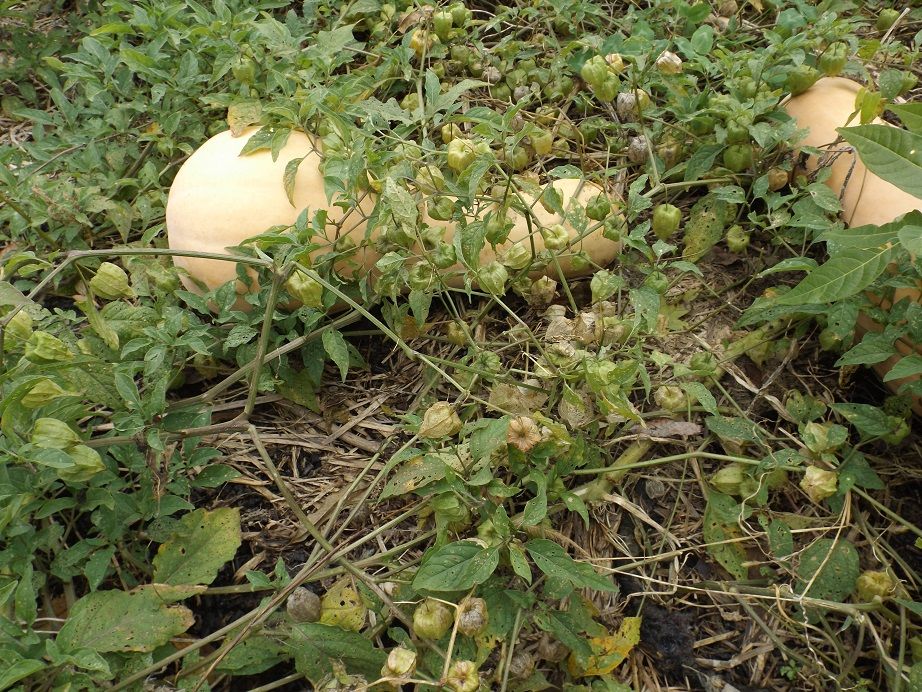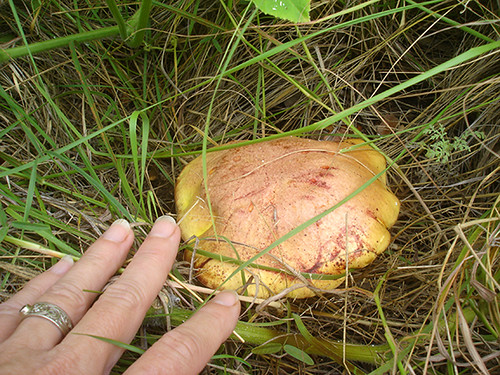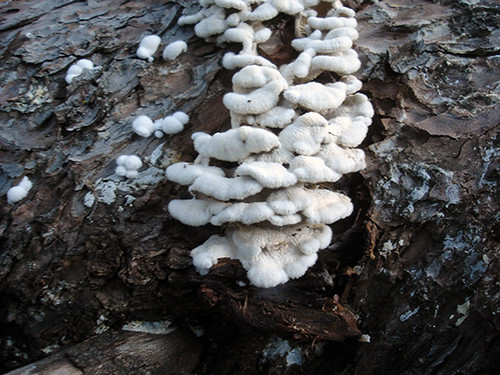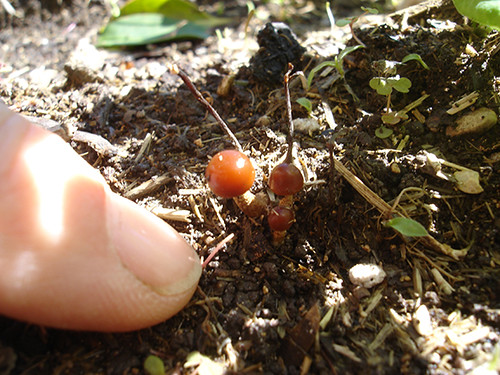|
|
Post by kyredneck on Oct 23, 2014 7:44:54 GMT -5
I've a small library on 'wild' food/mushroom foraging and something that caught my attention early on was that much of these 'wild' plants were actually introduced and naturalized from all over the globe whether intentionally or not. It seems some of these 'wild' plants have followed civilization wherever it goes. Here's a couple 'wild' plants from my squash patch:

Sow Thistle, native to Europe, once was a garden cultivar for greens, now considered a weed. IMO this is actually one of the best 'wild' greens around if harvested before the milk appears. I've actually saved 'wild' seed and sowed it in my garden many years ago but couldn't always catch that window of opportunity for perfect greens

Chinese Lantern aka ground cherry. Growing up I was told these were poisonous so I was slow to try them first time around. All other ground cherries I've seen around here are yellow/orange, these appear to be ripening purplish, we'll see. I learned here on this site a little while back that these can be hung in the basement to ripen after cold weather hits, and that's my plan to do.  |
|
|
|
Post by flowerweaver on Oct 23, 2014 7:55:14 GMT -5
My donkey and sheep enjoy Sow's Thistle at any stage. I just yell 'salad' when I'm weeding the garden and they come running. Wish I knew my mushrooms better.
|
|
|
|
Post by kyredneck on Oct 23, 2014 8:23:22 GMT -5
Most books list edible shrooms as 'edible', 'good', or 'choice'. Over the years I've gravitated to only the 'choice' ones. 'Edible' does NOT equate to 'palatable', at all.
Many years ago my brother and I while squirrel hunting a creek from a canoe came back with a boatload of 'Giant Puffballs', safe/easy to identify, listed as 'edible', we processed, packaged, and froze them BEFORE even sampling them, pans out it was like eating fried cardboard. Learned a lesson there, never again.
|
|
|
|
Post by kyredneck on Oct 23, 2014 8:31:18 GMT -5
I imagine your location in Texas is not a mushroom hunter's paradise, eh? Maybe during or right after the rainy season.
|
|
|
|
Post by blueadzuki on Oct 23, 2014 8:59:08 GMT -5
Around me, a very obvious one is fuzzy bean, Strophostyles helvola/leopserma/etc. (I've seen a lot of names, but based on the descriptions following them, it is unclear to me if there actually are multiple species or simply a lot of old species names being used synonomously. Certainly the fuzzy bean seed I have bought from down south seems the same as what I collect here) Technically this is a native to the area, but not to where I usually find it. Actually I'm not sure ANYONE knows where it is native to (the Native Americans thought it such a useful plant they liked to plant it around their camps, so separating truly originally wild sands from ones that are merely old camp leftovers (or descendants of seeds stolen by animals FROM old camps)is a bit hard). In and of themselves the beans should be fairly scarce around here, since there have been no Natives in the immediate area for around 400 years. But some time in the 1960's-70's the NYC used a wild mix including the beans as part of an erosion control plan. They don't do it anymore (the beans attract too many birds, squirrels and (in the urban part of the line) rats and mice.) But all up and down the railroad lines there are still decent patches. At the right season if you look out the train window, you can see the pink and purple flowers scattered here and there. At the moment every Wednesday I collect pods from the stand at my station; waiting for the train (I've got maybe 2oz. at the moment and will probably be able to get another 1/4 or so before the frost kills the plants)
There also USED to be quite a bit of naturalized American Groundnut (Apios americana) around, but I haven't seen any in recent years. Our never made any seed, so I assume it was triploid.
As for memories Back when I was a kid I used to spend summers at a nature camp up in Sturbridge, Massachusetts. The camp was on land that had been private for as far as anyone could remember. This led to a few bad things like the camp water supply, a private "well" that was actually a old hollowed out sulfur deposit so the water (which we were forced to drink 5-6 glasses of at every meal before we could drink anything else) tasted like rotten eggs. But it also meant the woods were unusually biodiverse (since no one had developed the land). The woods were filled with rare plants and animals like living stands of Prince's Pine (a clubmoss), and whatever kind of salamander it is that when it is young is bright orange with black dots (now you know why I call corn kernels that have blue dots covered with an orange pericarp "salamander" kernels). And with the exception of a few ultra protected plants (like the native lady's slippers) we were free to use ALL of it as we saw fit, INDCLUDING eating it (provided we had gone through the "this is edible" course). Many were meh, and some things were maddeningly frustrating like the beaked hazels (I drove me crazy that since I was only there in summer, the nuts were never ripe) But some things were great. I LOVED the taste of Indian cucumber root (Medeola virginiana). In fact I liked it so much that the morning I had to leave I got up early, went to the stand and collected seeds to try and start my own patch at home (didn't work, turns out you need a lot more marshy conditions that I have). And of course I became VERY popular the second year, when as soon as I had stashed my gear I went up to one of the paths and came back with BALES of sweet fern (Comptonia peregrine) leaves (sweet fern works GREAT as a mosquito repellent. The nutlets are edible too, though they were again never ready when I was there)
|
|
|
|
Post by Joseph Lofthouse on Oct 23, 2014 11:37:07 GMT -5
Wild foods that I most commonly eat are mushrooms, lambsquarters, hawthorn, chokecherry, mountain raspberry, asparagus, Oregon grape, rose hips, and plums. I gather a few wild herbs for tea: chamomille, mint, mullein, nettle, red clover, yarrow. It surprised me to learn recently that mullein isn't from around here.
I graze on the lambsquarters while weeding. I wouldn't intentionally pick it for use in the kitchen, but if it's already in my hand it might as well go into my mouth.
|
|
|
|
Post by kyredneck on Oct 23, 2014 12:30:18 GMT -5
The ‘Lamb’s Quarter’ in these parts is chenopodium album, another ‘wild weed’ native to Europe, but actually very good to eat, even raw like lettuce when young. Very nutritious also, akin to beets and spinach. Supposedly it was a garden cultivar at one time. |
|
|
|
Post by kyredneck on Oct 23, 2014 13:05:50 GMT -5
Blueadzuki, you know the wild things in your area, don't you? 'Sweet fern as a mosquito repellent', cool, I never knew that. I'm not familiar with the fuzzy bean, though supposedly it's indigenous to these parts also. The only groundnut I know of is 'chufa'; I've never seen Indian cucumber, Indian turnip is quite common here.
Railroads can be productive places to forage. When I was a young teenager my first foraging book was 'Stalking The Wild Asparagus' by Euell Gibbons. He provided such good descriptions of wild asparagus 'skeletons' (which by the way is native to the Mediterranean) that I was able to find and locate through the winter many 'wild' plants in the fence rows (sown from bird droppings) beneath overhead communication/power lines along the railroad I grew up next to. And I had never seen an actual live asparagus plant before, but was able to come back to these spots in the spring and boy! What a joy it was to eventually discover and forage 'wild' asparagus spears from these spots. [add] Over the years I developed an asparagus route (4-5 miles) that I walked several times each spring and would bring home to Mom enough for meals and for her to freeze. My family was not big asparagus eaters until I started bringing the fresh home; the mush in the can was all we knew prior to that.
|
|
|
|
Post by richardw on Oct 23, 2014 13:06:01 GMT -5
Lamb’s Quarter is called 'fathen' here, a common weed in my garden.
|
|
|
|
Post by blueadzuki on Oct 23, 2014 14:46:57 GMT -5
Technically, since camp was 100+ miles from my home it wasn't really "my area" But yes, I know my wildings (some of them, at least).
Not surprised about the Indian cucumber it's pretty rare these days (in fact a lot of my guides say don't eat it because it's too rare and if you see some, it should be left to reproduce). It was there for the same reason the hazels and clubmosses were there, no one had done anything to the land to remove them. Plus I think you can only find it on the East Coast (I don't know where you are so that may or may not explain things)
America groundnut is a leguminous vine that produced edible tubers. Think of it like a native version of jicama. Looks a little like a dinky version of wisteria or kudzu, except the flowers are rust red, not purple.
I actually just remembered another bit of plant nostalgia. A few years later, after I had gotten too old for that camp, I spent a summer at a camp in the Acadia National part in Seal Harbor, Maine. There wasn't as much wilding hunting (it was oceanographic camp, after all). but there were occasions where we walked parts of the camp. and they were pretty tolerant of us picking things if we were going to eat them. I astonished one of the councilors when I picked a leaf off the ground and chewed it. I was astonished she didn't know what wintergreen looked like (I was lucky the wintergreen was in berry. Wintergreen berries are delicious)
The one I really remember was the last afternoon before we went home. They took us to a big cliff in the part to watch the sun set. The cliff had a lot of raspberry bushes (and maybe a few blueberries, but I wasn't all that hungry (plus they were being mobbed by everyone else so I more concerned with finding a comfy space on the rock. Wandering around with my eyes to the ground I saw something scrubby on the ground with tiny black berries. Looking at it closer I discovered it was a patch of crowberry (which up till then I had only seen in books) so I collected a few berries. Suddenly the sun began to set so I flopped down to get a better angle. I then learned something else that might be of use to others. If you are ever camping on a rock and need to lie down, crowberry makes a dandy pillow (it's soft and springy).
|
|
|
|
Post by khoomeizhi on Oct 23, 2014 15:35:49 GMT -5
aside from lamb's quarters, groundnut (which i see wild fairly regularly around here), and chickweed, there's the fruits: a fair amount of native persimmon and pawpaw around, also muscadines, plus feral apples, blackcaps and blackberries and wild strawberries...i collect ground cherry varieties, and have been more taken with the native hairy ones than those open-ground mostly smooth ones (probably P. subglabrata? maybe longifolia...) either way, i always check them out when i see them.
spring shoots: solomon's seal, milkweed, smilax, sochan...tea from soft spring shoots of pines and firs. violets, flowers and young leaves. daylilies. have dug big sections of big naturalized stands for the tubers a few times - much better in the fall, but not terrible other times). dandelion greens. milkweed for flower buds or young pods, too.
hazels (good reminder, blueadzuki), also hickories and black walnuts. white and bur oaks (to leach and make meal)
wild onion/garlic.
tea from bracken fern works like sweet fern, apparently. lemonade from staghorn sumac.
cattails for everything.
puffballs need a good marinade, for real. for wild mushrooms, i really only trust myself with chantrelles, morels, hen of the woods, and puffballs at this point.
birch twigs as a flavoring.
have not been distinguishing between wild and 'wild' in this post. and definitely forgetting things.
edit: i should say, i'm a huge lambsquarters greens fan, and will frequently bypass things i've intentionally planted to have them instead. lambsquarters is my #1 go-to green for mulching up scrambled eggs, too.
|
|
|
|
Post by jondear on Oct 23, 2014 16:10:13 GMT -5
We harvest some wild things "in season". Field strawberries, highbush blueberries, blackberries, raspberries. We also occasionally get dandelion greens in the spring, but our absolute favorite is fiddleheads. We generally get a few grocery bags full just to blanch and freeze along with some to eat fresh.
As of late, chaga tea has become popular with some in my family. It's a medicinal mushroom/growth that grows on trees in the birch family.
|
|
|
|
Post by steev on Oct 23, 2014 18:35:49 GMT -5
I mostly eat ~12 unmistakable mushrooms, totally avoid ~12 unmistakable killers, and generally consider the multitude in-between probably not palatable, or likely to lead to unpleasant physical reactions.
I eat a lot of wild mustard, mostly leaves; the budding flower stalks are a luxury.
Patience Dock is very early Spring greens (cooks to a horrid olive-drab; I should try a bit of acid in the pan, might help); makes a very low-care perennial patch. Dries and powders easily, for adding to biscuits, soups, whatever.
New Zealand spinach is naturalized all along the coast, great for sopping up the pan-residue after frying a bit of beast; best I ever found was on the Emeryville mud-flats, leaves as big as my palm.
Miner's lettuce is good for salad; I'll cook milk thistle occasionally, good to help the liver cope with having been crop-dusted; elderberries make good wine, I've not tried the flower-fritters.
|
|
|
|
Post by philagardener on Oct 23, 2014 20:57:47 GMT -5
Railroads can be productive places to forage. All of our railroad right-of-ways are now herbicide-ed to the point of being scary to walk, let alone forage  |
|
|
|
Post by flowerweaver on Oct 23, 2014 21:05:00 GMT -5
I imagine your location in Texas is not a mushroom hunter's paradise, eh? Maybe during or right after the rainy season. Yep. Surprisingly there are many mushrooms after the few good rains we do receive, and each year I see new ones, but I have yet to positively identify any to eat. I think the spores must come in with the shredded bedding I use in the chicken coops and then compost. One year we had dozens of huge 5" brown puffballs under our oaks. I have eaten smaller white ones in the north Texas woods with a more knowledgeable botanist who showed me how to peel them and eat them raw. They were sweet and bland much like tofu. Recently I identified some that popped up in the soybeans as shaggy manes but I didn't eat them either. There are always a lot of them coming up in the donkey manure, and I've wondered what those are. They are kind of fragile, small and greyish brown with coolie hat caps and they don't particularly look appetizing. Recently I found these in with the pumpkins. At first I thought they were pumpkins!  These shelf-ear types have started growing on the logs from the downed pine:  And a bunch of these tiny things popped up in my raised beds:  Any idea what these are? Wild foods on our place include: acorns, mesquite beans, mulberry, grape, yucca root and flowers, prickly pear pads and tunas, wild garlic, agarita berries, chilipequin, Turk's cap fruit, ground cherry, condalia berry, lanceleaf & evergreen sumac berries for lemonade, hackberry, cattail, cucumber pellitory, Texas persimmon, devil's claw seeds, pecans, little walnuts, pepper grass. For medicines: lime prickly ash for tooth aches, kidneywood and agarita stems for anti-bacterial and anti-viral, juniper berries for a diuretic, willow bark for headaches, horehound for sore throats, broomweed for aches & pains, camphor weed for sprains, senna for constipation, prickly pear juice for sunburn and cuts, spiderwebs and yarrow for styptics, pennyroyal and horsemint for bug repellent, cleavers for bladder issues, walnut shell for parasites, mullein for earache, prickly poppy for pain, evening primrose for well being, goldenrod for urinary tract infection, passionvine and St johnswort for anxiety, verbena for digestive stress. That's just what's on my property, there's even more in my area. |
|